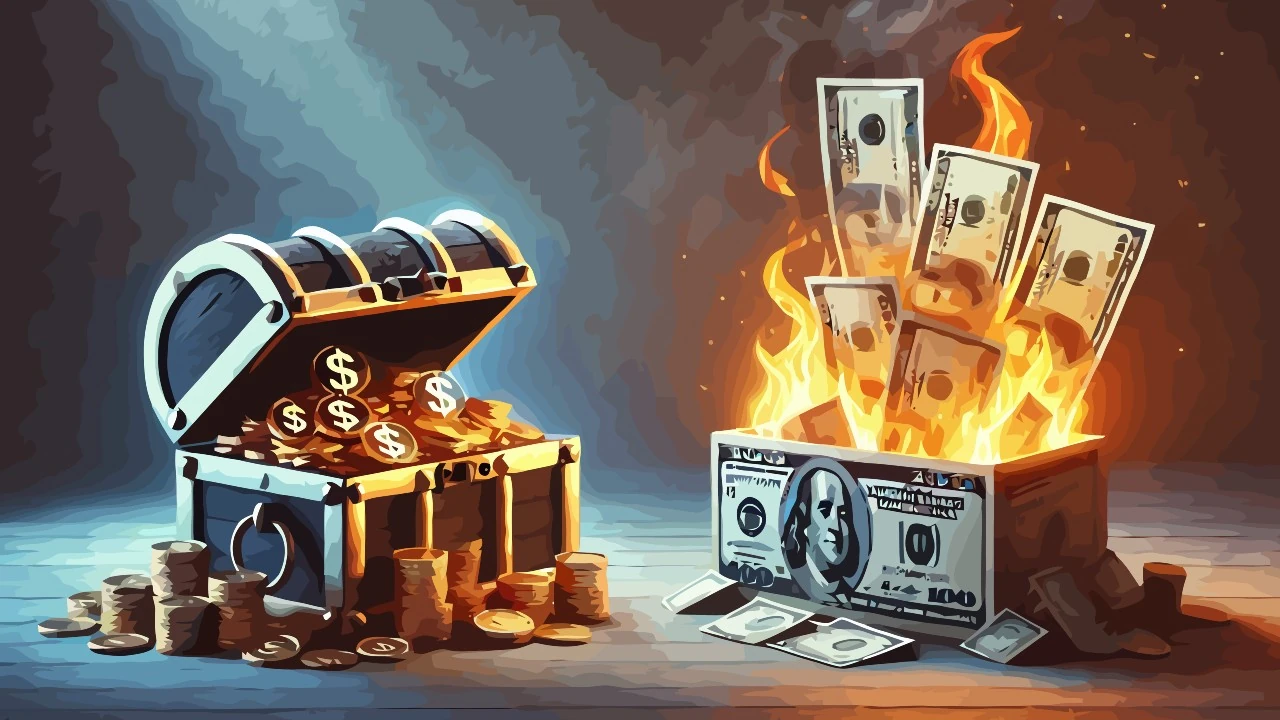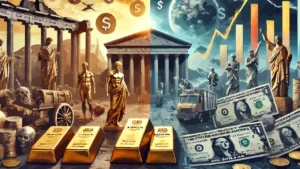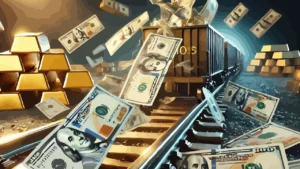We live in a world where money and currency are often considered synonymous, but they are not the same thing. The distinction between these two concepts is not just an academic question: it is the key to understanding global economic dynamics, inflation, and the loss of purchasing power. Michael Maloney, an expert on economics and precious metals, has clarified this difference, showing how modern currencies are simply “money” and not “money.”
In this article we will analyze in detail the characteristics of currency, those of money, and the reason why this distinction is essential to protect one’s assets.
Disclaimer:
The information provided does not constitute a solicitation for the placement of personal savings. The use of the data and information contained as support for personal investment operations is at the complete risk of the reader.
Contents
#1. Properties of currency
Currency must possess six fundamental characteristics to be used as a medium of exchange. According to Michael Maloney, currency must be:
- Medium of exchange: accepted by society to purchase goods and services,
- Unit of account: to allow the value of goods and services to be measured in a standardised way,
- Portable: Easily transportable and usable,
- Durable: maintain its shape and functionality over time,
- Divisible: to be divisible without losing value,
- Fungible: each unit must be equal to another of the same denomination.
These characteristics allow currency to function as a means of exchange in modern society. However, currency does not automatically guarantee the maintenance of value over time. Its primary function is to facilitate economic transactions, but its purchasing power can vary based on monetary policies and market confidence.
Another fundamental aspect of currency is that its validity is based on trust and government regulation. If this trust is lost, currency risks rapidly devaluing. Furthermore, technology and digitalization are influencing the concept of currency, leading to new forms of payment and transactions, such as cryptocurrencies. This leads us to reflect on the future of currency and its evolution in the global economic context.
#2. Properties of money
Money has all the characteristics of currency listed above, but in addition it has an additional distinctive feature:
- Store of value: it must not lose purchasing power over time, maintaining its purchasing power stable. Gold and silver are the only materials that have performed this function for millennia.
Unlike fiat money, which can be printed in unlimited quantities by central banks and governments, real money has a limited supply. This makes it immune to forced devaluations and ensures that its value will be maintained over the long term.
Historically, whenever a monetary system has abandoned its connection to sound money, hyperinflation and economic collapse have occurred. History shows us that gold and silver have been used as money for thousands of years precisely because they resist political and economic manipulation. Furthermore, money must be recognized globally and must maintain its intrinsic value regardless of the economic or political context in which it finds itself.
Another key aspect of money is its convertibility: while modern currency is backed only by trust in institutions, gold and silver can be exchanged anywhere without the risk of forced devaluation. This is why many investors and governments accumulate gold reserves as a form of protection against economic crises and currency fluctuations.
#3. Modern fiat money
Throughout history, governments have attempted to replace real money with fiat money, which is a currency with no intrinsic value. This system relies on the trust that the population has in institutions, but it has a fundamental problem: fiat money can be printed in unlimited quantities, leading to devaluation and loss of purchasing power. A striking example is the end of the Gold Standard in 1971, when the dollar ceased to be convertible into gold, becoming pure fiat money.
In recent decades, uncontrolled money printing has generated speculative bubbles and economic crises. The problem with fiat money is that it has no physical limit to its production, and when governments need liquidity, they can simply create money out of thin air. This mechanism erodes savings and leads to an uncontrolled increase in prices, reducing the purchasing power of the population.
The use of fiat money has led to a huge disparity between rich and poor, since those who have access to the new money first, such as banks and large companies, can benefit from the devaluation before it spreads to the general economy. This system, called the Cantillon effect , penalizes savers and encourages financial speculation. Furthermore, the uncontrolled expansion of money leads to the creation of speculative bubbles, which when they burst cause devastating financial crises.
Many economists argue that fiat money is an experiment destined to fail, as has happened in the past with many currencies that have devalued to the point of hyperinflation. The only way to protect yourself from this phenomenon is to understand the difference between money and currency, and adopt strategies to preserve your purchasing power over time.
#4. Inflation and purchasing power
One of the main problems of modern money is inflation. When a central bank prints money without a corresponding increase in the production of goods and services, the value of the money decreases. This phenomenon affects savers especially, who see their purchasing power slowly erode.
Inflation is not a random phenomenon, but a direct consequence of monetary policy. Central banks, by manipulating interest rates and the money supply, try to stimulate the economy, but often create speculative bubbles. When these bubbles burst, millions of people lose their economic power, while those who own tangible assets such as gold and silver are able to maintain their capital.
Inflation reduces the value of wages, increasing the cost of living without a corresponding increase in income. This phenomenon leads many people to seek alternative investments to protect their savings. Among these, gold and silver have proven over time to be the most reliable stores of value. During economic crises, investors tend to take refuge in precious metals, which maintain their value regardless of government policies.
The loss of purchasing power due to inflation is not uniform: while some sectors of the economy see a faster increase in prices, others may stagnate. This creates uncertainty and difficulties for families and businesses, which must adapt to an increasingly unstable economic environment. Furthermore, inflation undermines confidence in money, pushing more and more people to look for alternatives, such as cryptocurrencies and real estate investments.
Understanding inflation is essential for anyone who wants to protect their assets and ensure a stable financial future. Modern money does not offer sufficient protection against loss of value, which is why more and more people are turning to alternative financial instruments to protect their purchasing power.
#5. Money that resists time
Unlike fiat money, gold and silver have always retained their value over time. Their scarcity and difficulty in extraction prevent arbitrary devaluation. If we look at history, we can see that:
- In 1900, an ounce of gold could buy a high-quality suit,
- In 2025, with the same ounce of gold, you can still buy a high-quality suit.
The purchasing power of gold has remained stable or even increased over time, while currencies have lost much of their value.
Savvy investors use gold and silver as a store of value, protecting themselves from economic crises and currency devaluation. Gold , in particular, has been used as money for millennia and has always maintained its position as a global store of value.
In recent decades, the role of gold and silver has become even more crucial due to growing economic instability. Central banks in many countries accumulate gold reserves to protect themselves from monetary crises and the devaluation of national currencies. This confirms that despite financial innovations and digital currencies, the value of gold remains unchanged.
Gold and silver are also used in industrial and technological sectors, further increasing their demand and value. The scarcity of these precious metals ensures that they cannot be printed or artificially created, making them a solid hedge against inflation.
Those who invest in gold and silver do so to diversify their portfolios and reduce the risk associated with fiat currencies. In recent years, more and more people have turned to precious metals to protect their assets from the monetary erosion caused by global economic policies.
#6. Protecting yourself from value erosion
If modern money loses value, how can we protect our wealth? Here are some effective strategies:
- Convert part of your savings into gold and silver: precious metals that have historically held their value,
- Diversify your investments: Avoid keeping all your savings in a single currency or asset,
- Avoiding non-productive debt: Borrowing during times of high inflation can be dangerous,
- Investing in tangible assets: real estate, art, farmland can be an excellent hedge against inflation, even if they are less liquid than gold,
- Keep yourself informed: knowing the mechanisms of the economy is the first step to defend yourself,
- Monitoring the performance of financial markets: keeping up to date with global economic trends helps you make more informed decisions,
- Avoid the risk of fiat currency devaluation: Holding only cash in banks can expose your assets to monetary erosion.
Protecting yourself from the erosion of monetary value requires awareness and targeted actions. It is essential to diversify your resources and seek safe investments that can maintain their value over time. With the instability of financial markets and continuous economic crises, asset protection strategies become increasingly crucial.
One of the most effective tools for maintaining purchasing power is gold, which has proven to be a store of value in times of economic uncertainty. Silver, although more speculative and not always up to the performance of gold, also plays an important role in protecting capital.



Leave a Reply